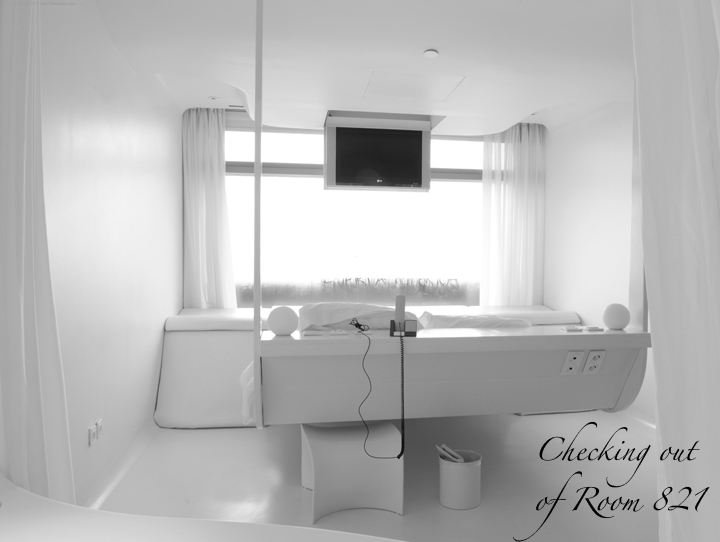Checking into Room 821, by Michelle Chaplow
From the moment this hotel opened its doors, it was an A-listed architectural sensation. Situated at number 41, Avenida de America, near Salamanca barrio in the Spanish capital, its striking red, yellow and orange exterior is impossible to miss as you travel in from the airport. The five-star hotel commenced construction in 2003 and was completed in 2005, but it wasn’t until almost a decade later that I made my first visit, in January 2014. The uniqueness of the Hotel Puerta America lies in the fact that a specific architect, or architects (mostly European), designed each floor, so that each has a totally distinct character.
The vibrant orange, yellow and red car park was designed by Teresa Sapey, the ground floor of the hotel by John Pawson, the first floor by Zaha Hadid, the second by Norman Foster (who also designed the Capella Hotel in Singapore and the Dolder Grand in Zurich), the third by David Chipperfield, the fourth by Plasma Studio (Castro and Kehne), the fifth by flamboyant Sevillano fashion designers Victorio & Lucchino, the sixth by Marc Newson, the seventh by Ron Arad, the eighth by Scottish designer Kathryn Findlay, the ninth by Richard Gluckman, the 10th by Arata Isozaki, the 11th by Fernando Salas and Javier Mariscal, and the 12th by Jean Nouvel. And as if this wasn´t enough, Christian Liaigre designed the restaurant, Marc Newson the bar, and Jason Bruges and Arnold Chan were in charge of lighting.
While I was on the way to Madrid, I saw a tweet announcing that Kathryn Findlay, who designed the eighth floor of the Hotel Puerta America, had sadly passed away from a brain tumour, aged 60. One of her most recent projects was the Orbit Tower in the London Olympic Park, which she co-designed with Anish Kapoor.
The Guardian newspaper reported: “The news of Findlay’s death came as the Architects’ Journal awarded her the Jane Drew Prize for her outstanding contribution to the status of women in architecture”. “She was one of the most talented people in British architecture,” said Eva Jiricna, one of the jurors. “I hope her work will be discovered by a new generation.” In this hotel you get the opportunity to do just that.
Works of art and design long outlive their creators, as I found when I checked in at the designer reception of the Puerta America, where the staff has that fashion attitude reminiscent of New York’s W hotels. I selected my room using the front desk’s iPad, choosing to spend the weekend on the very floor that Kathryn created.
The eighth floor, designed by the Scottish architect, felt like a cross between a futuristic space ship and an avant-garde white cruise vessel with curvaceous feminine lines; you can see the influence of Japanese minimalism – Japan was her home for many years, and it really shows.
Everything on the entire floor is white – the calming effect in the rooms is broken only by the silver B&O phone and the stainless steel bathroom fixtures. The only colour in this room is the colour that the guests bring with them. My deep blue bottle of Solan de Cabras water broke the code, but my sexy silver Cosmolite Samsonite case and my Apple laptop looked perfectly at home.
I didn’t even want to hang anything up in the open plan wardrobe, for fear of spoiling the visual harmony, but in the end I did hang a beige leather jacket, which blended perfectly into the scene.
The bed was back to front, so you lie looking out of the windows with your feet to the sofas, and a white bench-style headboard, which converts into a desk, behind your head. Since it rained all weekend, I spent quite some time watching the clouds – maybe, just maybe, those raindrops represented the tears being shed for Kathryn?

The bed was back to front, so you lie looking out of the windows. I spent quite some time watching the clouds” (click to enlarge).
I knew that I could go up and down in the lift to explore all the other designers’ floors of the hotel, but I didn’t; I remained faithful to the floor created by Kathryn Findlay. The other floors can wait – this was her special time.
The rows of pastel-coloured small circular lights, which Findlay designed with Jason Bruges, fascinated me; when you arrive at the eighth floor, the curved walls play tricks on your eyes if you look at them for too long.
The bath tub was inside the room, with a round shower curtain over the tub. When you fill the bath, condensation covers the windows, so you can write your story, send your message – as in any hotel, this is your very own space.
The room has a spaceship, almost ocean-like feel to it – to experience this feeling first-hand, you need to spend a night in one of Findlay’s spaces.
The bathroom reminded me of a friend’s catamaran, with a sliding door and no sharp angles between the floor and the walls. I felt quite at home – it reminded me of the infinity curve in my photo studio.
Every time I left the white room, and then walked out of the hotel, I had to close my eyes while transversing that vibrantly-coloured car park.
Kathryn has certainly created a space in Hotel Puerta America for dreaming, as was her stated intention: “a place of meditation where guests could dream or listen to the breeze.” A space where you add your own colour; a relaxing ambience, where you can watch the clouds drift by.
Whether you love or hate her white rooms in the hotel, Findlay was an architectural genius. She wrote her story, she sent her message and now we can sleep in her space. Her memory lives on and many guests will have the joy of discovering her unique vision when they stay on the eighth floor of the Hotel Puerta America.








I did love the experience. Great and fantastic !